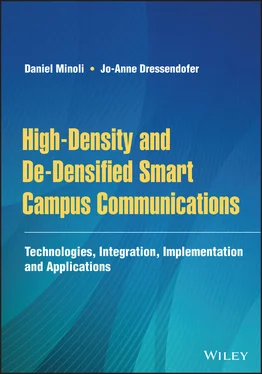The Wi‐Fi Alliance separated the introduction of 802.11ac wireless products into two phases (“wave”), named “Wave 1” and “Wave 2”. Initially, (2013) products were based on the IEEE 802.11ac Draft 3.0; it supported three spatial streams (with three antennas). Wave 2 certification became available in 2016; Wave 2 products achieve higher bandwidth and system capacity than Wave 1 products. Wave 2 included newer features such as MU‐MIMO, wider 160 MHz channel width support, additional 5 GHz channels, and four spatial streams (with four antennas; compared to three in Wave 1 and 802.11n) (IEEE's 802.11ax supports eight.) See Table 2.6for a “Cheat Sheet” on 802.11ac concepts and system throughput.
2.6 BRIEF PREVIEW OF IEEE 802.11AX
As a quick initial comparison, note that an amendment to the IEEE Std 802.11 (the IEEE 802.11ax amendment) was being developed at press time by the IEEE 802.11ax Task Group. The amendment defines a high‐efficiency WLAN for enhancing the system throughput in high‐density scenarios. Unlike previous amendments that focused on improving aggregate throughput, the IEEE 802.11ax amendment is focused on improving metrics that reflect the user experience, such as average per station throughput, the fifth percentile of per station throughput of a group of stations, and area throughput. Improvements aimed at targeting environments such as wireless corporate offices, outdoor hotspots, dense residential apartments, and stadiums. The principal focus of the IEEE 802.11ax amendment is on indoor and outdoor operation of the WLAN. The target for increases in average throughput per station is in the range of 5–10 times, depending on a given technology and scenario of the WLAN. Outdoor operation is limited to stationary and pedestrian speeds [2]. This HEW system marketed as Wi‐Fi 6 by Wi‐Fi Alliance saw initial deployment in late 2019.
As is the case in other 802.11 standards, 802.11ax is designed to operate in the Industrial Scientific and Medical (ISM) bands located between 1 and 6 GHz, including the 2.4 and 5 GHz bands traditionally utilized; additional bands between 1 and 6 GHz may be added as they become available. An aggregate theoretical data rate exceeding 10 Gbps is achievable. For dense deployments, throughput speeds can be four times higher than the throughput speed achieved with IEEE 802.11ac systems (the nominal data rate, however, is only around 37% faster under optimal circumstances). Another key goal of 802.11ax is to improve spectrum efficient utilization. To achieve this goal, better power‐control methods are utilized to minimize or avoid interference with neighboring networks. Also, OFDMA, higher order modulation at 1024‐QAM (see Table 2.7), and UL of MIMO and MU‐MIMO combined with DL of MIMO and MU‐MIMO are all utilized to further increase throughput. Additionally, dependability improvements of power consumption and enhanced security protocols, specifically, WPA3 were added.
TABLE 2.7 Modulation and Coding Schemes for Single Spatial Stream
| Modulation and Coding Scheme (MCS) |
ModulationScheme |
Coding Rate |
20 MHz Channels 1600 ns GI Data Rate (Mbps) |
40 MHz Channels 1600 ns GI Data Rate (Mbps) |
80 MHz Channels 1600 ns GI Data Rate (Mbps) |
160 MHz Channels 1600 ns GI Data Rate (Mbps) |
| 0 |
BPSK |
1/2 |
8 |
16 |
34 |
68 |
| 1 or 2 |
QPSK |
1/2 or 3/4 |
16 or 24 |
33 or 49 |
68 or 102 |
136 or 204 |
| 3 or 4 |
16‐QAM |
1/2 or 3/4 |
33 or 49 |
65 or 98 |
136 or 204 |
272 or 408 |
| 5 or 6 or 7 |
64‐QAM |
2/3 or 3/4 or 5/6 |
65 or 73 or 81 |
130 or 146 or 163 |
272 or 306 or 340 |
544 or 613 or 681 |
| 8 or 9 |
256‐QAM |
3/4 or 5/6 |
98 or 108 |
195 or 217 |
408 or 453 |
817 or 907 |
| 10 or 11 |
1024‐QAM |
3/4 or 5/6 |
122 or 135 |
244 or 271 |
510 or 567 |
1021 or 1134 |
Note: a GI of 800 ns results in slightly higher data rates (up to about 10% higher).
The average throughput per station is directly proportional to both an aggregate BSS throughput and an area throughput. A fifth percentile measure of the per station throughput, that is, a measure of the throughput achieved by 95% of the stations, may be used to determine that a desired distribution of throughput among a number of stations in an area is satisfied. Since the values of the metrics will depend on the scenario, the IEEE 802.11ax amendment focused on a relative improvement of the metrics compared to previous IEEE 802.11 revisions (e.g. IEEE Std 802.11‐2012 in a 2.4 GHz band and IEEE 802.11ac in a 5 GHz band). The amendment includes a capability to handle multiple simultaneous communications in both spatial and frequency domains, in both UL and DL directions [2]. Design goals include robustness in outdoor channels, higher indoor efficiency, and the use of OFDMA. Chapter 5will expand on these concepts.
1 1. Liu, G. and Jiang, D. (2016). 5G: vision and requirements for mobile communication system towards year 2020. Chinese Journal of Engineering 2016: 5974586. https://doi.org/10.1155/2016/5974586.
2 2. Noh, Y., Lee, D.W., Ahn, J.H. et al. (2019). Support Of Frequency Diversity Mode For Block Code Based Transmission in OFDMA. US Patent 10, 523, 483, 31 December 2019. Uncopyrighted.
3 3. Minoli, D. (2020). Positioning of blockchain mechanisms in IoT‐powered smart home systems: a gateway‐based approach. Elsevier IoT Journal, Special Issue on IoT Blockchains 10: 100147. https://doi.org/10.1016/j.iot.2019.100147. https://www.sciencedirect.com/science/article/pii/S2542660519302525.
4 4. Hedayat, A.R. and Kwon, Y.H. (2019). Mixed Fine/Coarse Sounding Methods For HE STAs for MIMO and OFDMA. US Patent 10, 505, 595, 10 December 2019. Uncopyrighted.
5 5. Kim, J., Ryu, K., Choi, J., and Cho, H. (2019). Method for Operating In Power Saving Mode In Wireless LAN System And Apparatus Therefor. US Patent 10, 524, 201, 31 December 2019. Uncopyrighted.
6 6. Chu, L., Wang, L., Zhang, H. et al. (2019). Method And Apparatus For Uplink Orthogonal Frequency Division Multiple Access Communication In A WLAN. US Patent 10, 524, 290, 31 December 2019. Uncopyrighted.
7 7. IEEE. (2012). Part 11: Wireless LAN Medium Access Control (MAC) and Physical Layer (PHY) Specifications. IEEE Standards 802.11.TM.‐2012 (Revision of IEEE Standard 802.11–2007), 29 March 2012, 1–2695, IEEE (The Institute of Electrical and Electronic Engineers, Inc.), New York, NY, USA.
8 8. IEEE. (2013). Part 11: Wireless LAN Medium Access Control (MAC) and Physical Layer (PHY) Specifications, Amendment 4: Enhancements for Very High Throughput for Operation in Bands below 6 GHz. IEEE Standards 802.11ac.TM.‐2013, 2013, 1–395, IEEE (The Institute of Electrical and Electronic Engineers, Inc.), New York, NY, USA.
9 9. Part 11: Wireless LAN Medium Access Control (MAC) and Physical Layer (PHY) Specifications, Amendment 2: Sub 1 GHz License Exempt Operation. IEEE http://P802.11ah.TM./D5.0 March 2015, 1–604, IEEE (The Institute of Electrical and Electronic Engineers, Inc.), New York, NY, USA.
10 10. https://standards.ieee.org/standard/802_11‐2012.html(accessed 3 January 2020.
11 11. CWAP Staff. 802.11 PHY Layers. Certified Wireless Analysis Professional, https://www.cwnp.com. Available online on November 2, 2020 at http://media.techtarget.com/searchMobileComputing/downloads/CWAP_ch8.pdf.
12 12. Menon, M.P., Ketchum, J.W., Wallace, M. et al. (2005). Beam‐steering And Beam‐Forming For Wideband MIMO/MISO systems. US Patent 6, 940, 917, Qualcomm, 6 September 2005. Uncopyrighted.
Читать дальше












